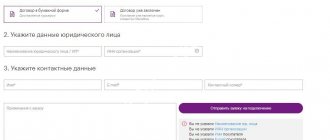What is the Internet of Things tariff?
To get an idea of the “Internet of Things” option, let’s look at its description and prices.
Tariff description
The tariff plan is designed for corporate clients, namely various companies and individual entrepreneurs who use devices with SIM card slots. This is the best option for those who have sensors and telemetry devices with cellular support.
The tariff replaced the “Manage remote objects” option, which is no longer available to clients. The Internet of Things is suitable for working in 2G, 3G and 4G networks. The offer includes access to the M2M monitoring platform, with which you can manage a network of devices regardless of location. The tariff features include the APN network, which guarantees the protection of transmitted information.
These conditions apply to devices operating in Russia. If you need to use services in another country, you must activate “IoT without borders”.
Subscription fee
The tariff does not imply a subscription fee. A standard size SIM card is issued absolutely free, a heat-resistant one costs 100 rubles, and for a SIM chip you have to pay 235 rubles. As part of the tariff plan, the company offers clients various services at a certain cost:
- Internet use – 1.5 rubles per 1 MB;
- use of a secure communication channel – 3.5 rubles per 1 MB;
- data transfer to Megafon subscribers - 1.4 rubles per minute, to clients of other companies - 3 rubles per 60 seconds;
- outgoing messages to Megafon clients - 1.5 rubles per 1 piece, to other subscribers - 1.8 rubles;
- outgoing call – 7 rubles per minute.
Prices may vary depending on the region where the SIM card was purchased.
Also provided. It allows you to record communication costs and provides the following capabilities:
- Internet speed 64 Kbps (unlimited);
- unlimited traffic of the NB-IoT data transfer protocol;
- monitoring the performance of equipment.
The cost for using this option is 100 rubles for 4 weeks. You can activate it in your Personal Account.
Description and features of M2M monitoring
The operator presents a wide range of business solutions for various tasks - this is Megafon IoT for communication within the country and abroad, as well as Megafon M2M monitoring. What is this technology?
M2M or Machine-to-machine is a special technology for exchanging data between several devices via a mobile network. The technology allows you to monitor the work of an organization remotely, gain insight into all processes and control overspending on communications.
Let's talk about what features Megafon M2M monitoring includes:
- Setting limits in rubles or traffic volume;
- Remote blocking of SIM cards;
- A good tariff with traffic rounding and a single cost for data transfer throughout the country;
- Possibility of using CSD and SMS packages;
- Control of IMEI change, as well as viewing information about the device;
- Connecting a dedicated APN, VPN and static IP address to protect data transmission;
- Geolocation and online diagnostics;
- Setting alerts about events occurring with the SIM card;
- Possibility of purchasing a SIM card with thermal protection that works in extreme conditions.
By the way, in May 2021, X Holding CJSC conducted research that proved that Megafon M2M monitoring is the best in the field of simplicity and ease of implementation of basic functions among other mobile operators.
Connecting to the Internet of Things tariff
To switch to the Internet of Things tariff, you must visit the Customer Service Center and enter into an agreement with the operator. Then you can activate the option using your Personal Account. To do this you need to do a number of manipulations:
- on the authorization page, enter your password and login;
- enter the symbols indicated in the picture;
- choose 1 of 6 proposed packages and additional options;
- activate the service.
It is permissible to connect the tariff in a communication salon.
Usually purchased together with the service
Personnel control
Monitor the location of your employees and control the use of working time.
Fleet control
Online monitoring of transport, control of fuel consumption and other parameters.
Videoconferences
Modern communication in real time with colleagues, partners and clients.
Mobile information
The service allows you to conveniently distribute information or advertising materials of your company using SMS messages.
Additional Information
To learn more about the tariff plan, let’s look at the most frequently asked questions online:
How to disable the Internet of Things option?
The user can disable the Internet of Things tariff from Megafon or replace it with another at any time on the official Megafon website. To stop cooperating with a company, you must terminate the contract by contacting the post office or sending a notice in writing.
Who is the tariff suitable for?
The offer is indispensable for companies with a developed computer network. It is effectively used by companies in the transport industry and banking sector, housing and communal services.
What to do if you can’t activate the tariff?
You must contact the company's employees at 0555 or 8-800-550-05-55. For questions regarding payment and contract management, you can write to
M2M technology
M2M SIM cards are used for data transfer. They are used in ATMs, video surveillance systems, and card payment terminals in stores. Utility providers install them in their meters to transmit data. Denis Kuskov, CEO of the TelecomDaily Information and Analytical Agency, told 360 about this.
“M2M is a regular SIM card, only installed on the meter and transmits not voice calls, but Internet data: indicators, fund transfer transactions, and so on,” he explained.
The expert noted that companies usually purchase several thousand M2M SIM cards at once to equip their equipment. But the law coming into force requires that all connected SIM cards be registered.
“This is where there is a point that does not allow, as when buying a simple SIM card, to present a person’s passport. Here it is necessary to carry out a certain level of technological and legal elaboration. These holidays were allocated for this in order to bring everything in accordance with the law,” said Denis Kuskov.
He noted that ordinary citizens do not need M2M SIM cards. For smart meters or smart home devices, they can use simple SIM cards that are inserted into the phone.
Online reviews
Reviews about the Internet of Things tariff plan are mostly positive. The advantages of the option include:
- the ability to connect to the M2M Monitoring service, which allows you to combine a network of software and hardware devices into a single ecosystem;
- fixation of monthly expenses for monitoring the movement of equipment;
- choice of one of six Internet packages (from 15 to 300 MB at a cost of 20 to 120 rubles);
- installing sensors in the most difficult places;
- low energy consumption.
Corporate clients are attracted by the opportunity to accurately plan costs with unlimited Internet for 100 rubles. A speed of 32 Kbps is enough to transfer data, for example, from water consumption meters.
Subscribers are confused by expensive outgoing calls. This tariff is not suitable for private clients. In general, the Internet of Things technology is an excellent option for institutions in various fields of activity, be it real estate, energy or logistics.
Do you have any doubts? Send a request and we will answer all your questions
M2M?Monitoring
M2M?Monitoring
Provides the ability to use all 14 M2M monitoring functions
- Setting limits in rubles, MB, minutes
- Lock SIM card by number/IMEI
- Diagnostics of activity of up to 10 SIM simultaneously
- View and notify about IMEI change
- 21 reports, schedule settings
- Group operations with SIM cards
- Sending SMS to M2M or external SIMs
- Viewing expenses by personal account/SIM card
- Setting up alerts for SIM card events
- SIM card location
- Open API (15 functions)
- Automatically adding SIM to the platform when connecting to the service
- Assigning a device type, viewing the model and manufacturer
- Assigning different access levels for employees
- Package 15 MB - 20 ? /month
- Package 25 MB - 30 ? /month
- 50 MB package - 45 ? /month
- Package 100 MB - 70 ? /month
- Package 200 MB - 90 ? /month
- Package 300 MB - 120 ? /month
- Package 15 MB - 45 ? /month
- Package 25 MB - 55 ? /month
- Package 50 MB - 70 ? /month
- 100 MB package - 95 ? /month
- Package 200 MB - 115 ? /month
- Package 300 MB - 145 ? /month
pdf Brochure with prices for the service pdf 391.3 KB
Cost and connection
Let's talk about what M2M tariffs Megafon can offer - you will be surprised how flexible and comfortable the conditions are developed by the operator.
The subscription fee for monitoring is thirty rubles per month. This amount includes the following functions of your personal account:
- Setting limits in rubles, MB and minutes;
- Block SIM card by number or IMEI;
- Diagnostics of card activity (up to 10 pieces);
- View and notify about IMEI change;
- Setting up a schedule and 21 reports;
- Carrying out group operations with SIM cards;
- Ability to send SMS to M2M or external SIM;
- Determining the location of the card;
- Open API;
- Analysis of expenses on a SIM card or personal account;
- Selecting access levels for different employees;
- Determining the device type;
- Activation of notifications about events with SIM;
- Adding a SIM card to the platform when connecting to the service.
"Control" modem
A large number of manufactured GSM/GPRS modules and terminals have built-in support for the POP3/SMTP, FTP, TCP/IP/UDP/DNS protocol stack. The simplicity of organizing computer access to the Internet on their basis and the analogy with the use of wired modems can create a feeling of absence of difficulties when used in industrial telemetry and telecontrol systems.
Connecting to the module a control controller that provides the generation of AT commands, an external power source and an antenna will ultimately not cause difficulties for experienced developers. The main questions begin to arise when solving the problem of ensuring sustainable operation:
- systems running on the desktop suddenly begin to fail and “freeze” when moving to real objects, when the operator changes or the network load increases;
- it turns out that significant efforts are required to handle emergency situations, testing, support for working with dynamic IP addresses, providing access to the state of the modem and network during data transfer, etc.;
Of course, there will be organizations that can solve the problems that arise - but is this economically justified for the majority?
All this leads to the appearance of complete solutions on the market. Their cost is, of course, a little higher, but this is the price for a kind of “Plug and Play” (“turned on and work”). Such systems may contain a control controller, but modern GSM/GPRS modules allow you to get rid of it by making the modem itself “controller”. Built-in programs turn the modem into a complete data transmission system, and in many cases, into a system for collecting, processing and transmitting data. Examples of the approach to programming modems are presented in the table.
Table. Examples of an approach to programming modems
Application
GLONASS/GPS
Transport monitoring is used not only at the level of enterprises in various fields of activity, but also at the level of cities and regions. Monitoring of municipal passenger motor transport enterprises makes it possible to improve the quality of transport services to the population, improve transport safety in general, improve the quality of services to the population, and also reduce budget costs.
An innovative transport monitoring system allows you to control the consumption of fuel and other fuels and lubricants, as well as guarantee the safety of goods and their timely delivery. Effective organization of work, reduction of mileage and downtime of transport, savings in fuel and lubricants are a small part of the results of the implementation of satellite monitoring.
How does GLONASS/GPS monitoring work?
GLONASS/GPS satellite tracking systems operate on the basis of determining the coordinates of the location of mobile or stationary objects relative to the positions of the satellites. Currently in Russia there are 2 types of monitoring of objects. The use of equipment that combines both types of monitoring, GLONASS and GPS, increases the reliability of the system by increasing the number of signals received from satellites, and also reduces the risk of low accuracy in determining location coordinates in dense urban areas and adverse weather conditions. Both GLONASS/GPS monitoring and GPS monitoring provide not only effective logistics, but also total control of every moving object, for example a car on which special equipment was installed. Satellite monitoring
significantly increases the efficiency of the enterprise as a whole.
Services provided by the GSM network for M2M
The GSM network uses the following services for data transmission: SMS (Short Message Service), CSD (Circuit Switched Data) and GPRS/EDGE (General packet radio Service / Enhanced Data for Global Evolution).
SMS – due to restrictions on the volume of transmitted data (160 characters), relatively high cost and lack of “guaranteed delivery”, it is mainly used in security and fire systems.
CSD – circuit switched service, speed up to 9.6 kbit/s (14.4 kbit/s when using HSCSD in one slot). Data is transmitted in the channel allocated when the connection is established. The V.42bis compression and error correction protocol is supported. Advantages: if the connection is established, the data will arrive in a fixed time. Disadvantages: time-based payment and difficulty of use in systems that require a quick response to an event (it takes time to get through).
GPRS/EDGE – service with packet data transfer, speed up to 171/473 kbit/s, permanent connection to the network (no need to dial the subscriber). Packets are transmitted over currently unused voice channels, which are always present in the intervals between subscriber conversations. Using several channels for transmission at once increases speed. Pros: constant readiness for data transfer and charging for the volume of transferred data, not the connection time. Disadvantage: allocation of slots on a residual basis.
Possibility of using GLONASS / GPS monitoring of moving objects
Transport monitoring
- only one of the areas of application of satellite vehicle tracking systems. The use of additional equipment allows you to control the temperature, keep track of the time and operating parameters of various units and attachments.
The use of satellite monitoring systems for vehicles provides information about the location of vehicles, allows for more efficient logistics, reduces costs for fuel and lubricants and controls unauthorized downtime.
The experience of implementing satellite monitoring systems for vehicles at enterprises in various fields of activity confirms that the efficiency of using vehicles is up to 40%.











